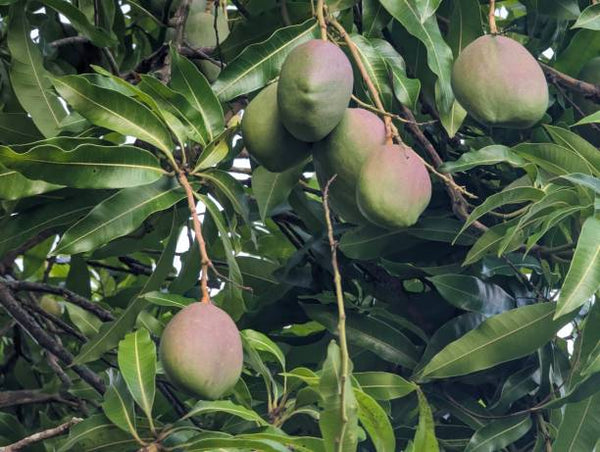Amaranth greens are getting a lot of attention for their incredible nutritional and culinary value. Often referred to as a "superfood", these vibrant leaves are packed with essential vitamins, minerals, and powerful antioxidants.
Amaranth greens, also known as Amaranthus belong to the Amaranthaceae plant family, which contains some 174 genera and around 2,500 species distributed worldwide. (1) Some are cultivated for their grain, and leafy greens, and others just growing wild.
Amaranth greens are available in a wide range of varieties, each offering unique flavors and textures. These are some of the ones we're currently growing at SoulFire Farm:
Amaranth tricolor: Also known as Chinese spinach, this variety features bright red and green leaves with a slightly tangy taste.
Red Amaranth: Boasts deep red stems and leaves, coupled with an earthy, slightly peppery flavor.
Green Amaranth: Known as slender amaranth, this type showcases thin, tender leaves and a delicate, nutty flavor.
Pink Stemmed Amaranth: known for its striking pink stems used for its colorful edible leaves, which have a mild, slightly earthy flavor.

Why are Amaranth Greens considered nutrition powerhouses?
Vitamins: Amaranth greens are an excellent source of vitamins, including A, C, and K.
Minerals: Amaranth greens contain vital minerals like iron, calcium, manganese, copper, and magnesium, promoting overall health.
Rich in antioxidants: Both green and red amaranth leaves are rich sources of antioxidants.
Fiber: Amaranth greens are high in fiber and can help support healthy digestion.
Protein: Amaranth greens are a decent source of protein containing 3 grams for every cup of boiled amaranth.
Amaranth Green's Amazing Nutritional profile
Amaranth is rich in protein when compared to other leafy greens. It contains 3 grams of protein per cup when cooked.
Amaranth greens are an excellent source of vitamin K, providing more than twice the Daily Value (DV) in a single raw cup.
They’re also high in vitamin A, vitamin C, and folate, as well as minerals like manganese, copper, potassium, and magnesium.
Eating your amaranth greens with fat, like olive oil, will help your body absorb more of the vitamins A and K since those vitamins are fat soluble.
Both green and red amaranth leaves are rich sources of antioxidants. The main antioxidants found in amaranth greens include carotenoids, betalains, betacyanins, betaxanthins, and chlorophyll (2).
Red and pink amaranth are higher in antioxidants that give the leaves and stems their bright color, especially betalain, betaxanthin, and betacyanin (3).
Amaranth greens have more than twice the amount of antioxidants than spinach and even more polyphenols (4).
* Nutritional Value based on 1 cup (132 grams) of boiled or steamed amaranth greens

Is Amaranth the New Kale?
In our opinion, when choosing between amaranth greens and kale, both nutrition and culinary aspects favor amaranth. Its protein content, diverse vitamin and mineral profile, and delightful taste and texture make it our preferred choice for a healthy and enjoyable culinary experience.
Whether you're an experienced chef or new to the kitchen, amaranth will elevate your meals with flavor, color, and nutrition.
Amaranth Greens in the Kitchen
Amaranth greens are perfect for salads, adding both color and nutrition. Their tender leaves and slightly peppery taste make them a great addition to your salads.
You can also cook amaranth greens in various ways to suit your taste. Try a simple sautéed amaranth greens recipe by heating some olive oil in a pan, adding minced garlic, and cooking the greens until they wilt, then seasoning with salt and pepper.
Additionally, you can incorporate amaranth greens into your soups and stews for added flavor and nutrition. Beyond that, these greens can be blended into green smoothies or used in omelets, quiches, and empanadas to boost their nutrition and flavor.

Amaranth Greens in Cultural Cuisines
Amaranth greens have a rich history and have played a significant role in culinary traditions worldwide.
- In Indian cuisine, known as "chaulai," amaranth greens find their place in traditional curries and lentil dishes, adding both flavor and nutrition.
- Across Africa, where they go by names such as "Inyabutatu," amaranth greens have been part of African diets for centuries, appreciated for their versatility in dishes like "Palava Sauce" and "Morogo."
- In Latin America, known as "Quelites" and "Bledo," they hold cultural significance, featuring in traditional preparations such as tamales, stews, and sautés.
- In Jamaica, amaranth greens are commonly referred to as "callaloo" or "callaloo greens are a key ingredient in the beloved "Callaloo" dish, a flavorful and hearty mixture of amaranth greens, okra, coconut milk, and spices, often served with rice and peas or bammy.
- In Trinidad and Tobago, amaranth greens, known as "bhagi," are sautéed with garlic, onion, and spices, creating a flavorful side dish or filling for sandwiches and rotis.
- Even in Europe, amaranth greens have found their way into modern cuisine, with chefs and home cooks experimenting with it in salads, quiches, and side dishes, recognizing their nutritional benefits.
From Asia to Africa, Europe to the Americas, amaranth greens have woven themselves into the global cuisine.






0 comments